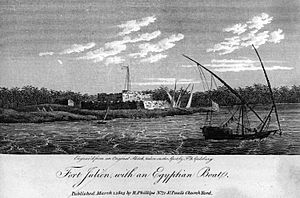Siege of Fort Julien facts for kids
Quick facts for kids Siege of Fort Julien |
|||||||
|---|---|---|---|---|---|---|---|
| Part of the French Campaign in Egypt and Syria of the French Revolutionary Wars | |||||||
 Fort Julien, with an Egyptian Boat, 1803 |
|||||||
|
|||||||
| Belligerents | |||||||
| Commanders and leaders | |||||||
| Strength | |||||||
| 306 | 2,000 | ||||||
| Casualties and losses | |||||||
| 41 killed or wounded 264 surrendered |
10 casualties | ||||||
The Siege of Fort Julien was an important military event during the French Revolutionary Wars. It happened in Egypt from April 8 to April 19, 1801. This battle was part of the larger French campaign in Egypt and Syria.
During the siege, about 2,000 British and Ottoman soldiers surrounded Fort Julien. Inside the fort, there were only about 300 French soldiers. The British and Ottoman forces worked together to try and capture the fort.
Contents
What Was Fort Julien?
Fort Julien was a old fort in Egypt, built in the 1400s. The French army took it over in 1799 and quickly rebuilt it. They named it after Thomas Prosper Jullien, who was a helper to Napoleon Bonaparte.
The fort was very important because it was on the Nile River, near a town called Rosetta. It helped the French control the river and the path to Cairo. French boats called gunboats also patrolled the river nearby.
The Rosetta Stone Discovery
An amazing discovery happened while the French were rebuilding Fort Julien. Soldiers found the famous Rosetta Stone there. This stone was key to understanding ancient Egyptian writing!
Who Was Defending the Fort?
In 1801, a British force landed in Egypt. General John Hely-Hutchinson sent soldiers to capture Rosetta and Fort Julien. The fort was defended by about 300 French soldiers. These included experienced veterans and infantry.
The Siege Begins
On April 8, 1801, British soldiers marched towards Rosetta. They were joined by 1,000 Ottoman troops. Together, they moved to surround Fort Julien. The British 2nd (The Queen's Royal) Regiment of Foot, led by Lord Dalhousie, began the siege.
Bringing in the Big Guns
Getting cannons ready for the attack was very difficult. It took eight days to move the heavy artillery into place. Seven gunboats had to be pulled over three miles of sand and mud to reach the Nile.
Large naval cannons were also brought from the seashore. These 24-pound cannons were dragged four miles over land. General Robert Lawson decided to use these naval cannons. He thought the fort's new walls might not be fully hardened yet.
The Attack and Surrender
On April 16, the cannons were ready and the attack began. The soldiers focused their fire on one corner of the fort. After two days, on April 18, a part of the wall collapsed. This left the French soldiers inside exposed to Turkish sharpshooters.
Seeing their situation, the French soldiers waved white flags. After talking, they agreed to give up the fort.
What Happened Next?
At 11:00 AM on April 19, 1801, the remaining 264 French soldiers marched out of Fort Julien. The French had 41 soldiers killed or wounded. The British side had only three casualties.
Capturing Fort Julien was a big win. It opened up the Nile River for the British and Turkish fleets. After this, the town of Rosetta was taken without any fighting.
Later, the British army moved on to surround Cairo. On June 27, the large French army in Cairo, led by General Augustin Daniel Belliard, surrendered. They were outnumbered and outgunned. General John Moore then helped escort the French soldiers to the coast.

